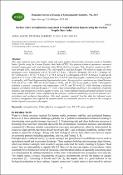Options
Surface water eutrophication assessment in Noakhali Sadar Upazila using the Carlson trophic state index
Journal
Romanian Journal of Ecology & Environmental Chemistry
ISSN
2668-5418
Date issued
2025-07-15
Author(s)
Akter, Asma
Noakhali Science and Technology University
Sarker, Protima
Noakhali Science and Technology University
Rahaman, Shiblur
Noakhali Science and Technology University
DOI
10.21698/rjeec.2025.101
Abstract
This study aimed to assess the trophic status and water quality characteristics of twenty ponds in Noakhali Sadar Upazila using the Carlson Trophic State Index (CTSI). Key physical-chemical parameters measured included temperature, pH, total dissolved solids (TDS), dissolved oxygen (DO), electrical conductivity (EC), total nitrogen (TN), total phosphorus (TP), chlorophyll-a, and Secchi depth. The observed ranges for these parameters were: temperature (24-32 °C), pH (6.7-8.42), TDS (46-1604 ppm), DO (4.33-7.46 ppm), EC (91-3208 µS cm⁻¹), TN (0.7-5.6 mg L⁻¹), TP (1.6-122 µg L⁻¹), chlorophyll-a (0.545-8.250 µg L⁻¹), and Secchi depth (0.22-1.13 m). CTSI values ranged from 38.31 to 68.38, indicating trophic conditions from oligotrophic to eutrophic, with Pond-8 approaching hypereutrophic status. Strong positive correlations were found between TDS and EC (r=1.00), TDS and Secchi depth (r=0.63), and EC and Secchi depth (r=0.63). Chlorophyll-a exhibited a positive correlation with temperature (r=0.57) and TP (r=0.52), while showing a moderate negative correlation with Secchi depth (r=–0.46). These relationships underscore the complexity of nutrient dynamics and transparency in these aquatic systems. The results highlight significant spatial variation in pond water quality and trophic status, emphasizing the need for continuous monitoring to prevent nutrient over-enrichment and ecological degradation. This study provides essential baseline data for informed water resource management and supports the implementation of sustainable practices to preserve the ecological health of pond ecosystems in the region.
Files
Loading...
Name
Articol 01 Full.pdf
Size
954.33 KB
Format
Adobe PDF
Checksum
(MD5):c0c871523bac339b28f37943270b4c50